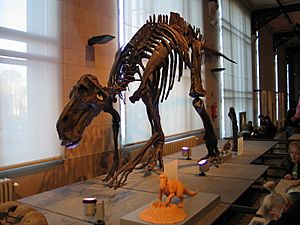Maiasaura facts for kids
Quick facts for kids MaiasauraTemporal range: Late Cretaceous
|
|
|---|---|
 |
|
| Maiasaura skeleton | |
| Conservation status | |
|
Fossil
|
|
| Scientific classification | |
| Kingdom: | |
| Phylum: | |
| Class: | |
| Superorder: | |
| Order: | |
| Suborder: | |
| Infraorder: | |
| Family: | |
| Subfamily: | |
| Genus: |
Maiasaura
|
| Binomial name | |
| Maiasaura peeblesorum |
|
Maiasaura was a large, plant-eating, duck-billed dinosaur. It was the first dinosaur found with its young, eggs, and nests. This discovery showed that Maiasaura cared for its babies.
Contents
Discovering Maiasaura
Scientists found Maiasaura fossils in Montana, United States. These fossils included nests, eggs, and young dinosaurs. This was a very important discovery. It helped us learn how some dinosaurs raised their families.
What Maiasaura Looked Like
Maiasaura was a big dinosaur. It grew to be about 9 metres (30 feet) long. It stood about 2 to 2.5 metres (6.5 to 8 feet) tall. This dinosaur weighed around 1800 kg (4,000 pounds).
Maiasaura had a special mouth shape. It had a wide, flat snout, like a duck's bill. This helped it eat plants.
The "Good Mother Lizard"
The name Maiasaura means "Good Mother Lizard." It got this name because of how it cared for its young. Scientists believe Maiasaura lived in herds. They built nests close to each other. This was like a dinosaur nursery.
Baby Maiasaura were born small. They probably stayed in the nest for a while. Their parents would bring them food. This shows that Maiasaura were very caring parents.
Maiasaura's Diet and Habitat
Maiasaura was a herbivore. This means it only ate plants. Its diet included plants, leaves, and berries. It lived about 80 to 65 million years ago. This was during the late Cretaceous period.
The area where Maiasaura lived was warm. It had lots of plants for them to eat. This made it a good home for these plant-eating dinosaurs.
Images for kids
-
Skull cast, Royal Ontario Museum
-
Reconstructed cast by Jack Horner of a Maiasaura emerging from its egg
-
Illustration of a herd of Maiasaura walking along a creekbed, as found in the semi-arid Two Medicine Formation fossil bed. This region was characterized by volcanic ash layers and conifer, fern and horsetail vegetation.
See also
 In Spanish: Maiasaura peeblesorum para niños
In Spanish: Maiasaura peeblesorum para niños







